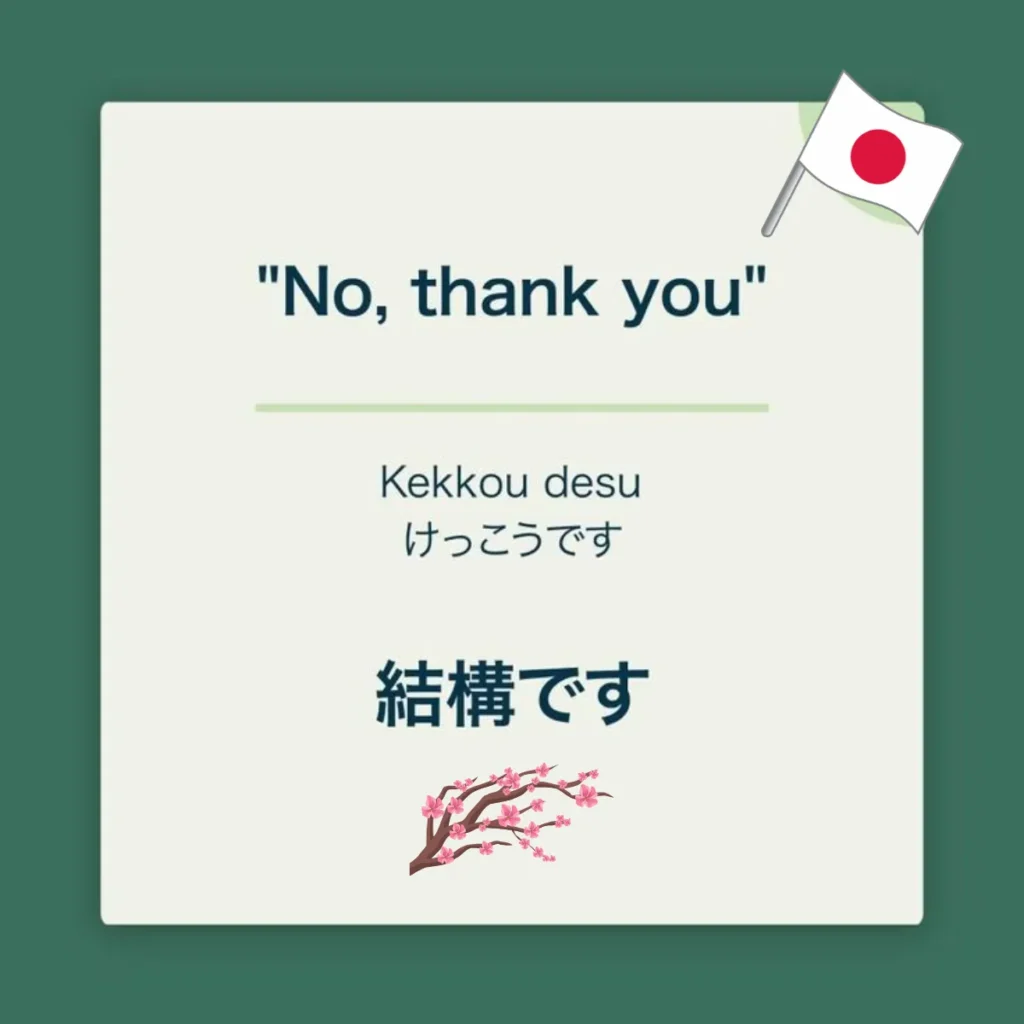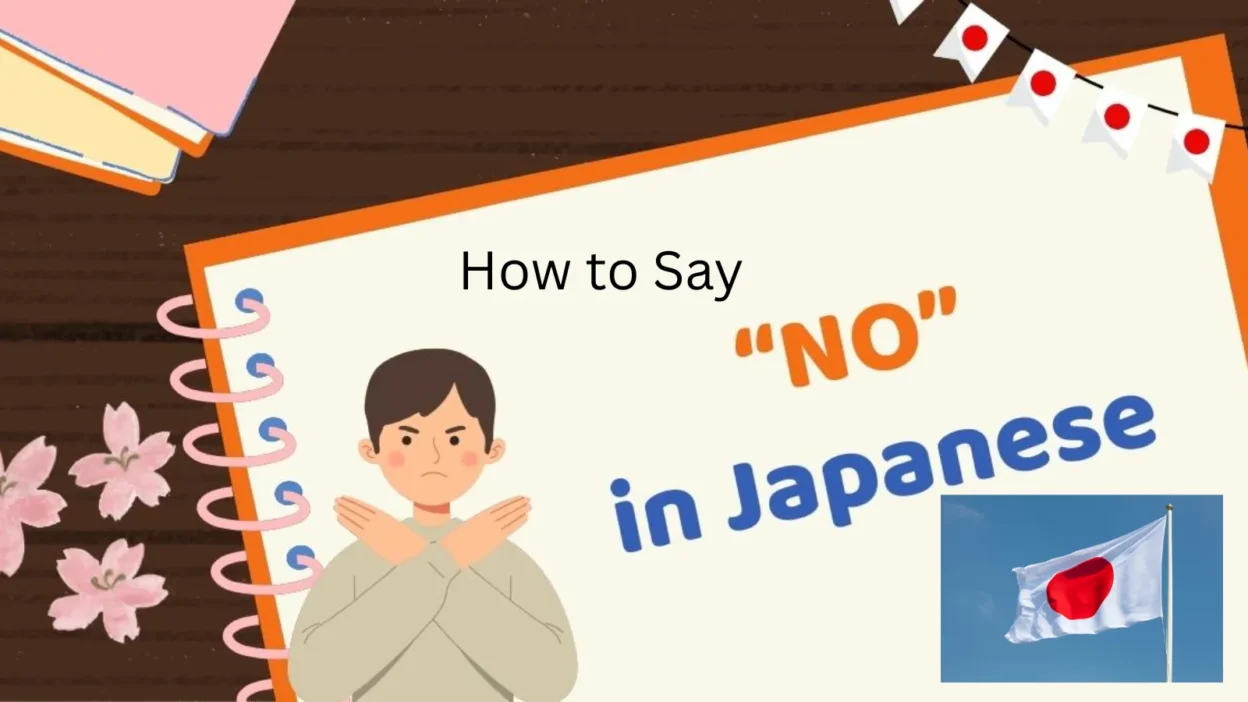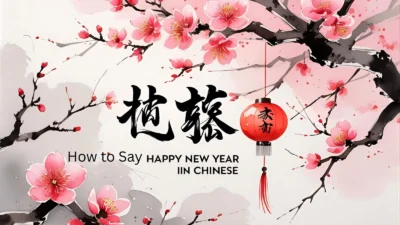Learning how to say no in Japanese is an essential skill for navigating conversations politely and respectfully.
In Japanese culture, direct refusals can sometimes be considered too blunt, so people often use softer, more indirect expressions.
Whether you’re declining an offer, refusing a request, or expressing disagreement, knowing the right phrases will help you sound courteous and culturally aware. In this guide, you’ll discover multiple ways to say no in Japanese, along with their meanings and proper contexts.
No in Japanese
Here’s a clear table of 15 ways to say No in Japanese with pronunciation, meaning, and context:
| Japanese Phrase | Pronunciation | Meaning | Context |
|---|---|---|---|
| いいえ | Iie | No | Standard, polite refusal |
| いや | Iya | No / Nah | Informal, casual situations |
| だめです | Dame desu | Not allowed / No good | Formal, when refusing politely but firmly |
| だめ | Dame | No / Not okay | Informal, casual |
| 無理です | Muri desu | Impossible | Polite but firm rejection |
| 無理 | Muri | Impossible | Informal refusal |
| 違います | Chigaimasu | That’s wrong / No | Polite correction |
| 違う | Chigau | Wrong / No | Informal correction |
| 結構です | Kekkou desu | No, thank you | Polite decline of an offer |
| 結構 | Kekkou | No, thanks | Casual refusal |
| ごめんなさい、できません | Gomen nasai, dekimasen | Sorry, I can’t | Polite and apologetic refusal |
| 今は無理です | Ima wa muri desu | It’s not possible right now | Polite and situational refusal |
| 遠慮します | Enryo shimasu | I’ll pass | Polite, modest way to say no |
| お断りします | Okotowari shimasu | I refuse | Very formal and strong refusal |
| それはちょっと… | Sore wa chotto… | That’s a bit… | Polite indirect refusal, leaving sentence unfinished |
1. いいえ (iie) – “No”
Origin & Context:
This is the direct translation of “no” and one of the first words learners encounter. However, it’s surprisingly not used that often in everyday conversation due to its bluntness.
Example:
👤 User A: コーヒー飲みますか?(Kōhī nomimasu ka? – Would you like coffee?)
👤 User B: いいえ、大丈夫です。(Iie, daijōbu desu. – No, I’m okay.)
Use:
Formal, but can sound cold or strong if not used carefully.
2. ちょっと… (chotto…) – “Umm, well…”
Origin & Context:
Literally means “a little…” but used as a soft refusal. Often followed by silence or trailing off, allowing the speaker to imply “no” without saying it directly.
Example:
👤 User A: 今夜映画に行かない?(Kon’ya eiga ni ikanai? – Want to go to the movies tonight?)
👤 User B: うーん、ちょっと… (Uun, chotto… – Umm, not really…)
Use:
Very common; polite and indirect.
3. 結構です (kekkō desu) – “No, thank you”

Origin & Context:
Literally means “That’s fine,” but often used to politely decline offers.
Example:
👤 User A: お水、いかがですか?(Omizu, ikaga desu ka? – Would you like some water?)
👤 User B: いえ、結構です。(Ie, kekkō desu. – No, thank you.)
Use:
Polite and formal; often used in restaurants or service situations.
4. 遠慮します (enryo shimasu) – “I’ll pass”
Origin & Context:
“Enryo” means to hold back out of consideration. It’s a culturally respectful way to say “no.”
Example:
👤 User A: ケーキ食べる?(Kēki taberu? – Want cake?)
👤 User B: 今日は遠慮します。(Kyō wa enryo shimasu. – I’ll pass today.)
Use:
Polite and modest; shows humility.
5. 無理です (muri desu) – “It’s impossible”

Origin & Context:
“Muri” means unreasonable or not doable. This is a more direct way to reject a request due to difficulty.
Example:
👤 User A: 明日までに終わる?(Ashita made ni owaru? – Can you finish it by tomorrow?)
👤 User B: 無理です。(Muri desu. – That’s not possible.)
Use:
Firm but polite; often used in workplace settings.
6. できません (dekimasen) – “I can’t”
Origin & Context:
From the verb “dekiru” (to be able to), this is a formal way of saying you cannot do something.
Example:
👤 User A: 手伝ってくれる?(Tetsudatte kureru? – Can you help me?)
👤 User B: ごめんなさい、できません。(Gomen nasai, dekimasen. – Sorry, I can’t.)
Use:
Polite, useful for formal or apologetic refusals.
7. そうは思いません (sō wa omoimasen) – “I don’t think so”
Origin & Context:
Used in discussions or debates. It’s a polite disagreement, not a flat-out “no.”
Example:
👤 User A: 彼が正しいと思う?(Kare ga tadashii to omou? – Do you think he’s right?)
👤 User B: そうは思いません。(Sō wa omoimasen. – I don’t think so.)
Use:
Useful in professional discussions or academic contexts.
8. いや (iya) – “No” / “I don’t like it”

Origin & Context:
A more casual or emotional rejection. Can sound harsh depending on tone.
Example:
👤 User A: カラオケ行こうよ!(Karaoke ikō yo! – Let’s go to karaoke!)
👤 User B: いや、今は行きたくない。(Iya, ima wa ikitakunai. – No, I don’t feel like it now.)
Use:
Casual or emphatic; not for formal settings.
9. ダメです (dame desu) – “That’s not okay”
Origin & Context:
“Dame” means “no good” or “not allowed.” It’s often used in rules, discipline, or denial.
Example:
👤 User A: ここに座っていい?(Koko ni suwatte ii? – Can I sit here?)
👤 User B: そこはダメです。(Soko wa dame desu. – That spot is not okay.)
Use:
Firm and clear; used in rules or permissions.
10. 違います (chigaimasu) – “That’s not right”
Origin & Context:
Often used to correct someone politely. “Chigau” means “to differ.”
Example:
👤 User A: あなたが田中さんですか?(Anata ga Tanaka-san desu ka? – Are you Mr. Tanaka?)
👤 User B: いいえ、違います。(Iie, chigaimasu. – No, that’s not correct.)
Use:
Polite correction; not an emotional “no.”
11. ちょっと難しいですね (chotto muzukashii desu ne) – “That’s a bit difficult”
Origin & Context:
Another soft refusal, commonly used in business. It implies the task isn’t practical.
Example:
👤 User A: 来週会える?(Raishū aeru? – Can we meet next week?)
👤 User B: ちょっと難しいですね。(Chotto muzukashii desu ne. – That might be tough.)
Use:
Polite and diplomatic; often used to decline indirectly.
12. ごめんなさい、無理です (gomen nasai, muri desu) – “I’m sorry, I can’t”
Origin & Context:
Combines apology with firm refusal. Useful in balancing directness with politeness.
Example:
👤 User A: 今日飲みに行こう!(Kyō nomi ni ikō! – Let’s go drinking tonight!)
👤 User B: ごめんなさい、無理です。(Gomen nasai, muri desu. – Sorry, I can’t.)
Use:
Polite with clear boundaries.
13. 今回はやめておきます (konkai wa yamete okimasu) – “I’ll skip this time”
Origin & Context:
Literally means “I’ll stop for now.” It’s a culturally appropriate way to bow out without rejection.
Example:
👤 User A: 一緒に行く?(Issho ni iku? – Want to go together?)
👤 User B: 今回はやめておきます。(Konkai wa yamete okimasu. – I’ll pass this time.)
Use:
Polite and non-confrontational.
14. ちょっと考えさせてください (chotto kangae sasete kudasai) – “Let me think about it”
Origin & Context:
Used to delay a decision politely. May imply a “no” depending on context.
Example:
👤 User A: この仕事、引き受けてくれる?(Kono shigoto, hikiukete kureru? – Can you take this job?)
👤 User B: ちょっと考えさせてください。(Let me think about it.)
Use:
Indirect; leaves space for future decisions.
15. それはちょっと… (sore wa chotto…) – “That’s a bit…”
Origin & Context:
A vague but culturally accepted refusal. “That’s a bit…” usually means “no” without saying it.
Example:
👤 User A: 明日朝6時集合ね!(Ashita asa rokuji shūgō ne! – Let’s meet at 6am tomorrow!)
👤 User B: それはちょっと… (Sore wa chotto… – That’s a bit much…)
Use:
Softest form of “no.” Often used to avoid confrontation.
Conclusion:
Mastering how to say no in Japanese isn’t just about learning the words—it’s about understanding the cultural importance of politeness and subtlety.
By using the right phrases in the right situations, you can refuse respectfully while maintaining harmony in your interactions.
With these expressions in your toolkit, you’ll be able to navigate conversations in Japan with confidence and cultural sensitivity.



